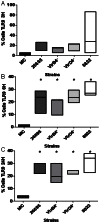Impact of cagPAI and T4SS on the inflammatory response of human neutrophils to Helicobacter pylori infection
- PMID: 23755130
- PMCID: PMC3670914
- DOI: 10.1371/journal.pone.0064623
Impact of cagPAI and T4SS on the inflammatory response of human neutrophils to Helicobacter pylori infection
Abstract
Helicobacter pylori contains a pathogenicity island, cagPAI, with genes homologous to components of the type IV secretion system (T4SS) of Agrobacterium tumefaciens. The T4SS components assemble a structure that transfers CagA protein and peptidoglycan into host epithelial cells, causing the increased release of interleukin 8 (IL8) from the cells. The Toll-like receptors on neutrophils recognize H. pylori, initiating signaling pathways that enhance the activation of NF-κB. However, the roles of cagPAI and T4SS in the inflammatory response of neutrophils are unknown. We evaluated the participation of cagPAI and T4SS in the response of human neutrophils to H. pylori infection. Neutrophils were isolated from the blood of healthy donors and infected with H. pylori cagPAI(+), cagPAI(-), and cagPAI mutant strains virB4 (-) and virD4 (-). Whereas cagPAI(+) strain 26695 induced the greatest IL8 production, a proinflammatory response, cagPAI(-) strain 8822 induced the greatest IL10 production, an anti-inflammatory response. In contrast, the virB4 (-) and virD4 (-) mutant strains produced significantly more of the two proinflammatory cytokines IL1β and tumor necrosis factor αthan the cagPAI(+) strain 26695. We observed that H. pylori downregulated the expression of TLRs 2 and 5 but upregulated TLR9 expression in a cagPAI and T4SS-independent manner. These results show for the first time that the response of human neutrophils to H. pylori may vary from a pro-inflammatory to an anti-inflammatory response, depending on cagPAI and the integrity of T4SS.
Conflict of interest statement
Figures






References
-
- Ernst PB, Gold BD (2000) The disease spectrum of Helicobacter pylori: the immunopathogenesis of gastroduodenal ulcer and gastric cancer. Annu Rev Microbiol 54: 615–640. - PubMed
-
- Akira S, Uematsu S, Takeuchi O (2006) Pathogen recognition and innate immunity. Cell 124: 783–801. - PubMed
-
- Abdelsadik A, Trad A (2011) Toll-like receptors on the fork roads between innate and adaptive immunity. Hum Immunol 72: 1188–1193. - PubMed
-
- Alvarez-Arellano L, Camorlinga-Ponce M, Maldonado-Bernal C, Torres J (2007) Activation of human neutrophils with Helicobacter pylori and the role of Toll-like receptors 2 and 4 in the response. FEMS Immunol Med Microbiol 51: 473–479. - PubMed
-
- Koller B, Bals R, Roos D, Korting HC, Griese M, et al. (2009) Innate immune receptors on neutrophils and their role in chronic lung disease. Eur J Clin Invest 39: 535–547. - PubMed
Publication types
MeSH terms
Substances
Grants and funding
LinkOut - more resources
Full Text Sources
Other Literature Sources
Medical

